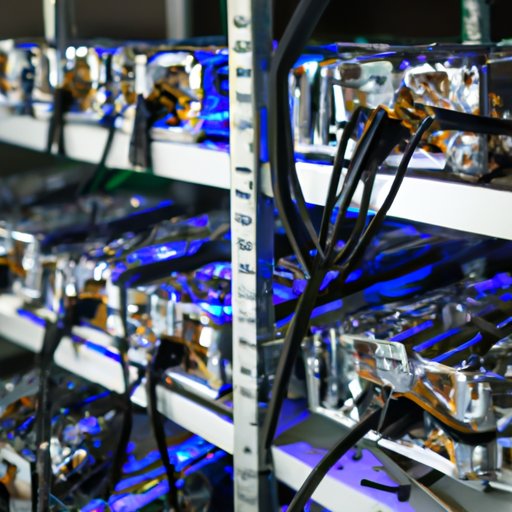Introduction
Mining Ethereum is a process that involves using specialized hardware to solve complex mathematical equations in order to earn rewards in the form of Ether. Ethereum miners compete with each other to solve these equations and the miner who solves them first earns the reward. This process is known as Proof-of-Work (PoW) consensus mechanism.
In order to start mining Ethereum, you will need to acquire the necessary hardware and software components. You will also need to research suitable mining pools and create a crypto wallet for storing your mined Ethereum.

Identify the Necessary Hardware and Software for Mining Ethereum
The first step in mining Ethereum is to identify the necessary hardware and software components. These components include a graphics card, central processing unit (CPU), motherboard, random access memory (RAM), power supply unit (PSU), operating system (OS) and mining software.
The most important component is the graphics card, which is responsible for the majority of the computing power needed to mine Ethereum. You will need a powerful graphics card such as an AMD Radeon RX 580 or Nvidia GeForce GTX 1080 Ti. If you don’t have a powerful graphics card, you can still mine Ethereum using your CPU, although it will take significantly longer to mine a block.
You will also need a compatible motherboard, RAM, PSU and OS. The PSU must be able to handle the power requirements of the graphics card, and the OS should be Windows 10 or Linux.
Once you have identified the necessary hardware components, you will need to install mining software. Popular mining software includes Claymore’s Dual Miner and PhoenixMiner.
Research Suitable Mining Pools
Mining pools are groups of miners that work together to increase their chances of solving a block and earning Ether. When a block is solved, the reward is shared among all members of the pool based on the amount of work they contributed.
When researching suitable mining pools, you should consider factors such as the size of the pool, fees, server locations and payment methods. You should also look for pools that have good reputations and customer support.
Set Up a Crypto Wallet for Storing Ethereum
Before you start mining Ethereum, you will need to set up a crypto wallet. A crypto wallet is a digital wallet that allows you to store, send and receive cryptocurrencies such as Ethereum. It is important to choose a secure wallet such as MetaMask or Myetherwallet.
Creating a crypto wallet is straightforward. All you need to do is visit the website of the wallet provider and follow the instructions. Once you have created your wallet, you will be given a unique address which you can use to receive Ether.
Configure Your Mining Rig
Once you have acquired the necessary hardware and software components and set up a crypto wallet, you can begin configuring your mining rig. This involves connecting all of the components together and installing and configuring the mining software.
Connecting the components is relatively straightforward; however, the exact process will depend on the type of components you are using. The installation and configuration of the mining software can be done by following the instructions provided by the manufacturer.

Monitor Your Progress and Optimize Performance
Once your mining rig is up and running, you will need to monitor its progress and make sure it is working properly. This can be done by keeping track of your hashrate and troubleshooting any issues that may arise. You can also optimize your mining performance by adjusting settings such as the clock rate and memory clock.
Conclusion
Mining Ethereum at home is a viable option for those looking to earn rewards in the form of Ether. In order to do so, you will need to acquire the necessary hardware and software components, research suitable mining pools, set up a crypto wallet and configure your mining rig. You will also need to monitor your progress and optimize performance in order to maximize your rewards.
(Note: Is this article not meeting your expectations? Do you have knowledge or insights to share? Unlock new opportunities and expand your reach by joining our authors team. Click Registration to join us and share your expertise with our readers.)
